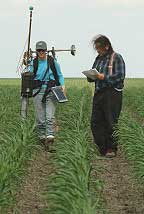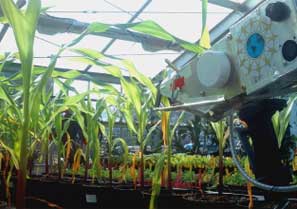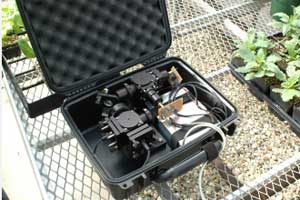 |
|
Margaret Ingalls (left) and Steve Finkelman measure
properties of corn leaves using the N-Checker.
Credit: Photo
by Aaron Woodbury |
July 19, 2005
By firing
rapid pulses of polarized light at corn, spinach and other
crops, researchers have uncovered a picture of plant health that
is invisible to the naked eye. Using a portable light source and
detector technology, the researchers can differentiate minute
differences in leaf colors - indicators of over- or
under-fertilization, crop-nutrient levels and perhaps even
disease.
The
researchers hope their tractor-mountable N-Checker (for
"nitrogen-checker") apparatus will help farmers determine in
real time how much fertilizer to apply. By preventing waste, the
system could decrease the cost of crop production and
dramatically cut the nitrogen-laden runoff responsible for algal
blooms and other damage to wetlands and waterways.
Steve
Finkelman, Paul Nordine and their colleagues at Containerless
Research, Inc. of Evanston, Ill., Louise Egerton-Warburton and
partners at the Chicago Botanic Garden, and graduate student Tim
Smith of the University of Illinois, Urbana-Champaign, will
present their new technology July 19 at the InfoAg 2005
Conference in Springfield, Ill.
"With our
technology, we are able to easily see what is hidden from
conventional instruments," says Finkelman. "The system
eliminates interference from light reflected at a leaf's surface
and allows us to see light re-emitting from within."
Depending
on the plant, leaves reflect, transmit and absorb varying
amounts of light. Polarized light that enters a leaf's interior
can lose its polarity and be re-emitted as "depolarized" light.
The depolarized light reveals nitrogen content and other
properties the proprietary sensors in the N-Checker can detect.
 |
|
Bearing the NSF logo, the original depolarized
light-sensor apparatus assesses stressed plant leaves in
this controlled greenhouse at the Chicago Botanic Garden
under the direction of Louise Egerton Warburton. The
researchers have also field tested both systems from
cart and body based platforms.
Credit: Steven Finkelman, CRI |
 |
This
image shows the first prototye N-Checker sensor
components within a protective carrying case.
Credit: Aaron Woodbury |
Changes in
nitrogen levels change the way light interacts with the
molecules in the leaf, characteristically affecting the spectrum
of light that re-emits from the plant. Chlorophyll molecules, in
particular, contain nitrogen atoms that play a critical role in
photosynthesis.
The
researchers have experimented with two versions of their
apparatus. The original version channels broad-spectrum light
from a xenon flashlamp through a series of calcite crystals to
illuminate each corn, sugar beet, cotton or other broad-leaf
crop with a tiny, transient spot of polarized light. Moving from
leaf to leaf, that system can measure nitrogen levels in 60
plants per minute.
Instead of
a broad-spectrum lamp as its source, the N-Checker uses two
red-light sources that cut down on sensor and polarizer costs
and increase the system speed. The red region of the
electromagnetic spectrum is important because it reveals not
just total chlorophyll content, but also relative amounts of the
various types of chlorophyll molecules.
"Other
devices use both red and infrared wavelengths," says Finkelman.
"Those devices tend to be imprecise because they measure bulk
chlorophyll content, which can result from a number of factors."
By using two specific, visible, red wavelengths, the N-Checker
can differentiate among the several types of chlorophyll
molecules and therefore reveal nitrogen-dependent plant health
information.
The
N-Checker can take 1000 measurements per second--at least every
10th of an inch--while moving at roughly 5 miles an
hour. At that speed, a farmer could survey and fertilize tens of
acres in a day, or hundreds of acres per day with a multi-sensor
system.
This
research was supported by NSF Grant #DMI-0319826
SBIR Phase I: Polarization
Sensing of Stress Levels in Vegetation
http://www.nsf.gov/awardsearch/showAward.do?AwardNumber=0319826 |